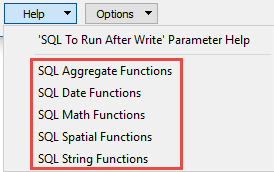|
About Database Connections |
|---|
|
Database formats include a Database Connection parameter that defines and stores authentication information. For general information about sharing database connections, please see Using Database Connections. Note that Database Connection parameters differ slightly, depending on context and/or database format. |
|
Connection From the Connection parameter in a database format, you can do one of the following:
|
Database Connection
Select an existing Actian Ingres database connection, or Add Database Connection...
|
Add Actian Ingres Database Connection To define a new connection from the Connection parameter in an Actian Ingres format, see the topic Actian Ingres Spatial: Add Database Connection |
The number of features that FME places in each transaction before a transaction is committed to the database.
The default value is 1000.
This parameter defines the time, in seconds, after which a query will be terminated if it has not yet returned a result.
If set to 0, there is no timeout. The default is 30.
Note: If this value is not set high enough, then the query will return the error Provider Error – Timeout Expired.
Max. Reconnect Attempts
This parameter defines how many times in succession will FME attempt to recover from a dropped connection.
- 0 (default) – If a connection is dropped, the writer will fail the translation.
- 1 or more – If a connection is dropped, the writer will make n attempts to reconnect. The writer will also keep a cache of features that have not yet been committed. After recovering from a dropped connection, the writer will continue writing from its cache, so that no features are dropped along with the connection. Due to the extra step in writing to the cache, overall writing speeds may be slower in this mode.
The counter for reconnection attempts is reset when a connection is successfully recovered.
This parameter allows for the execution of SQL statements before writing to a table. For example, it may be necessary to clean up a table before attempting to write to it. The statements will be executed only when the first feature arrives at the writer.
For detailed information about SQL functions, click the corresponding menu item in the .
Available menu options depend on the format.
Multiple SQL commands can be delimited by a character specified using the FME_SQL_DELIMITER directive, embedded at the beginning of the SQL block. The single character following this directive will be used to split the SQL block into SQL statements, which will then be sent to the database for execution. Note: Include a space before the character.
For example:
FME_SQL_DELIMITER ; DELETE FROM instructors ; DELETE FROM people WHERE LastName='Doe' AND FirstName='John'
Multiple delimiters are not allowed and the delimiter character will be stripped before being sent to the database.
Any errors occurring during the execution of these SQL statements will normally terminate the reader or writer (depending on where the SQL statement is executed) with an error. If the specified statement is preceded by a hyphen (“-”), such errors are ignored.
This parameter allows for the execution of SQL statements after a set of tables has been written. For example, it may be necessary to clean up a temporary view after creating it.
For detailed information about SQL functions, click the corresponding menu item in the .
Available menu options depend on the format.
Multiple SQL commands can be delimited by a character specified using the FME_SQL_DELIMITER directive, embedded at the beginning of the SQL block. The single character following this directive will be used to split the SQL block into SQL statements, which will then be sent to the database for execution. Note: Include a space before the character.
For example:
FME_SQL_DELIMITER ; DELETE FROM instructors ; DELETE FROM people WHERE LastName='Doe' AND FirstName='John'
Multiple delimiters are not allowed and the delimiter character will be stripped before being sent to the database.
Any errors occurring during the execution of these SQL statements will normally terminate the reader or writer (depending on where the SQL statement is executed) with an error. If the specified statement is preceded by a hyphen (“-”), such errors are ignored.

